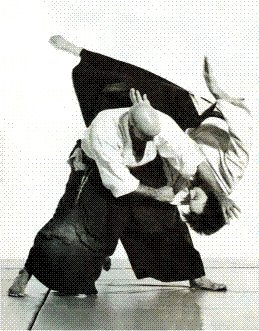Minoru Mochizuki y Tadashi Abe
Rescatando un viejo tema de aikidojournal.com a colación de qué es Aikido y qué no lo es. Se trata de una anécdota ocurrida al Maestro Minoru Mochizuki concerniente al escepticismo de un joven Tadashi Abe. Enjoy:
Había un hombre llamado Tadashi Abe, recientemente fallecido. En cierta ocasión en que visité a O Sensei en al dojo de Iwama para saludarle tras mi regreso a Japón al finalizar la guerra [WWII], tuve el siguiente encuentro con él. O Sensei se encontraba feliz al saber que yo había regresado sano y salvo y me dio una calurosa bienvenida. Me quedé a dormir esa noche en el dojo. Esa noche vino a mi habitación un hombre de aspecto malvado con un corte de pelo a lo monje y me pidió permiso para entrar. Cuando le di el permiso él entró.
Minoru Mochizuki, 10º Dan—“Me llamo Tadashi Abe. Sensei, ¿puedo hacerle una pregunta directa?”
Le dije que me preguntara lo que quisiera. Me preguntó si realmente estudiaba Aikijujutsu de manera seria. En aquellos tiempos el arte aun no tenía el nombre de Aikido. Cuando le respondí afirmativamente, me dijo lo siguiente:
—“¿En serio? Llevo mucho tiempo oyendo cosas sobre Vd., Sensei. He oído que ha tenido experiencia real en combate. Me parece extraño que alguien como Vd. Se encuentre satisfecho con un arte como el Aikijujutsu”.
Tadashi Abe, 6º DanCuando le pregunté por qué pensaba así me contestó que ni Ueshiba Sensei ni el Sr. Morihiro Saito serían capaces de resistir un combate contra él ni siquiera tres minutos. Que él les derrotaría de un solo golpe.
—“Estás muy seguro de ti mismo, ¿no?”, contesté. “¿De verdad crees que puedes derrotar a Ueshiba Sensei?”, añadí.
Contestó que creía que sería fácil para él derrotar a Sensei y aun añadió:
—“He estado observando a Ueshiba Sensei durante mucho tiempo y no me convence practicar un arte como el Aikijujutsu. Estoy seguro de que le puedo derrotar con solo un golpe de boxeo. He oído que Vd. pone énfasis en el combate, ¿es cierto?”
Le contesté como sigue:
—“He estado en muchas peleas callejeras, pero no incluiría eso en la categoría de ‘combate’. Y también he asaltado campamentos enemigos sable en mano”.
Entonces me preguntó si realmente el Aikido era útil o no para pelear. Cuando yo le respondí que el Aikido no sólo era útil en peleas sino también en tiempos de guerra me dijo que mi respuesta no le convencía. Entonces le sugerí que me atacara y me quedé allí, indicándole que me atacara como mejor supiera. Me pidió que me pusiera en guardia. Le contesté:
—“No pidas cosas innecesarias. No hay manera de derrotar al enemigo si él le dice lo qué hacer. ¡Atácame como quieras!”
Abe murmuró: “Sensei, ¿realmente puedo golpearle? Es extraño… tiene aperturas por todas partes…” Entonces se puso en guardia y me atacó de repente. Esquivé el golpe [taisabaki] y le di una patada. Gruñó y cayó al suelo. Inmediatamente apliqué una técnica de resucitación [katsu] y le di un masaje.
—“¿Cómo puede alguien como tú, que se desmorona y pierde el conocimiento cuando recibe una pequeña patada, durar algo en una pelea?”
—“Sensei, ¿es que el Aikido incluye técnicas de pateo?”
—“¡Estúpido! ¿Qué quieres decir con esa pregunta? Empleamos técnicas de pateo o lo que haga falta. Incluso he empleado artillería. Las artes marciales, las armas y la artillería, todas son Aikido. ¿Qué es lo que crees que es el Aikido? ¿Crees que se trata de retorcer muñecas? Es un medio de Guerra… ¡una acción de Guerra! El Aikido es una lucha con sables de verdad. Empleamos la palabra ‘Aiki’ porque con él podemos sentir la mente del enemigo que viene a atacar, de manera que podemos responder de manera inmediata. Mira el Sumo. Cuando dan la voz [Miatte! Miatte!] se levantan y se lanzan el uno contra el otro en un flash. Eso mismo es ‘Aiki’. Cuando una persona se enfrenta a un enemigo estando en un estado mental libre de toda idea o pensamiento y es instantáneamente capaz de lidiar con él, a eso lo llamamos ‘Aiki’. En los tiempos antiguos se llamaba ‘Aiki no jutsu’. Así, la artillería o cualquier cosa de convierte en ‘Aiki’”.
—“¿Así es…? Creo que ya entiendo”.
—“Si aun no lo entiendes, ven a verme cuando quieras”.
Después de este episodio Abe me tomó miedo y me saludaba desde lejos. Pero cuando fui enviado [por Ueshiba O Sensei] a Europa me pidió que le llevara como asistente.
Durante mi tiempo en Europa también tuve experiencias interesantes. Como practicábamos cosas como luxaciones de muñeca algunas personas se preguntaban si este tipo de entrenamiento realmente sería útil en una lucha real y me hacían muchas preguntas, así que les di la siguiente explicación:
—“Cuando practicamos, aprendemos la manera correcta de mover el cuerpo y cómo emplear la fuerza [kokyu ryoku] de manera racional. Mediante el uso del ‘Aiki’ puedes ser capaz de responder inmediatamente en cuando un enemigo se acerca acechando para atacar. De esta manera puedes sacudirte de encima a cualquiera”.
Así que un estudiante me preguntó: “¿Entonces puedo traer una pistola? Si empleo una pistola, Sensei, ¿qué haría Vd.?”
Mi respuesta fue que entonces yo traería un rifle.

 Every response you execute when grabbed can be done when grabbing. Every atemi you execute when attacked can be used when attacking. We need to lose this whole uke / nage dichotomy. We also need to stop attaching pseudo moralistic value judgments to things like who initiates.
Every response you execute when grabbed can be done when grabbing. Every atemi you execute when attacked can be used when attacking. We need to lose this whole uke / nage dichotomy. We also need to stop attaching pseudo moralistic value judgments to things like who initiates. The Art of Aiki es la más completa fuente de información sobre el Aikido en Español. |
The Art of Aiki es la más completa fuente de información sobre el Aikido en Español. |